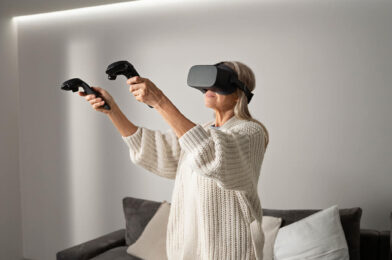Introduction
Virtual Reality (VR) has come a long way since its inception, and one of the key factors contributing to its immersive experience is the refresh rate of VR headsets. But what exactly is a refresh rate, and why does it matter so much in the world of VR? Buckle up, because we’re about to dive deep into the world of Smooth Operators: VR Headset Refresh Rates Explained!
The Basics: What is Refresh Rate?
Before we jump into the VR-specific details, let’s break down what a refresh rate actually is. Simply put, the refresh rate is the number of times per second that a display updates its image. It’s measured in Hertz (Hz), and a higher number means a smoother, more fluid visual experience.
For example, a 60Hz display refreshes 60 times per second, while a 90Hz display refreshes 90 times per second. The higher the refresh rate, the less likely you are to notice any flickering or motion blur, especially during fast-paced movements.
Why Refresh Rates Matter in VR
In the realm of VR, refresh rates are even more crucial than in traditional displays. Here’s why:
- Immersion: A higher refresh rate contributes to a more believable and immersive virtual world. When the visuals update more frequently, your brain is more likely to accept the virtual environment as “real.”
- Motion Sickness Reduction: One of the biggest hurdles in VR adoption has been motion sickness. Higher refresh rates can significantly reduce this issue by minimizing the lag between your head movements and the corresponding visual updates.
- Responsiveness: In VR games and applications, quick reactions are often necessary. A higher refresh rate means less delay between your actions and the visual feedback, leading to a more responsive and enjoyable experience.
- Comfort: Extended VR sessions can be taxing on the eyes. Higher refresh rates can reduce eye strain and fatigue, allowing for longer, more comfortable VR experiences.
The Evolution of VR Refresh Rates
Let’s take a quick trip down memory lane to see how VR refresh rates have evolved:
- Early VR (2016): The first consumer VR headsets, like the original Oculus Rift and HTC Vive, featured 90Hz refresh rates.
- Mid-Generation (2019): Headsets like the Valve Index pushed the boundaries with a 120Hz refresh rate, with an experimental 144Hz mode.
- Current Generation (2021-present): We’re seeing a range of refresh rates, from budget-friendly options at 72Hz to high-end headsets boasting 120Hz or even 144Hz.
FAQs: Your Burning Questions Answered
Q1: Is a higher refresh rate always better?
While higher is generally better, it’s not the only factor to consider. Other aspects like resolution, field of view, and overall performance also play crucial roles in the VR experience. Additionally, higher refresh rates require more processing power, which can impact battery life in standalone headsets.
Q2: Can I feel the difference between 90Hz and 120Hz?
Many users report a noticeable improvement when moving from 90Hz to 120Hz, especially in fast-paced games or applications. However, the difference may be less pronounced for casual users or in slower-paced experiences.
Q3: Do all VR apps support high refresh rates?
Not necessarily. While most modern VR apps are designed to take advantage of higher refresh rates, some older applications may be capped at lower rates. Always check the specifications of both your headset and the apps you’re interested in.
Q4: How does refresh rate affect VR performance?
Higher refresh rates require more processing power from your VR system. This means that to maintain a smooth experience at higher refresh rates, you may need a more powerful PC or standalone headset.
The Future of VR Refresh Rates
As technology continues to advance, we can expect to see even higher refresh rates in future VR headsets. Some prototypes have already demonstrated refresh rates of 240Hz or even higher! However, the real challenge lies in balancing these high refresh rates with other important factors like resolution, field of view, and affordability.
Conclusion: Finding Your Sweet Spot
When it comes to VR headset refresh rates, there’s no one-size-fits-all solution. While higher refresh rates generally offer a smoother, more immersive experience, they also come with increased hardware demands and potentially higher costs.
For casual VR users, a refresh rate of 90Hz might be perfectly sufficient. However, if you’re a VR enthusiast, a competitive gamer, or someone who spends extended periods in virtual environments, investing in a headset with a higher refresh rate could significantly enhance your experience.
Ultimately, the best refresh rate for you will depend on your specific needs, budget, and the type of VR experiences you enjoy most. As you explore the world of VR, pay attention to how different refresh rates feel to you, and don’t be afraid to test out various options before making a decision.
Remember, the goal is to find the sweet spot that provides the most immersive, comfortable, and enjoyable VR experience for you. Happy virtual exploring!
